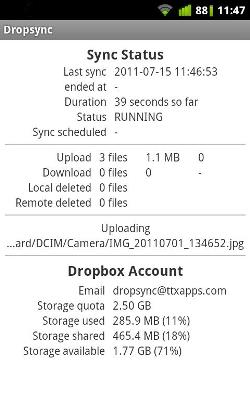

#Dropsync for ipod install#
It also means that some of your testers will be out in the field when they install the apps, instead of at home using Wi-Fi, which can help you spot issues related to 3G bandwidth and its effect on the responsiveness of an app’s functions. That means more feedback for developers, says Alex Okafor, a mobile application developer who shared the details of the new method on his blog. With easier distribution, more beta testers are likely to actually install and try your apps. Developers will still need access to the device IDs (UDIDs) and will still need to create provisioning files, but the actual distribution of the apps makes it far, far easier on those receiving the applications for testing. Thanks to this feature, developers can distribute mobile apps wirelessly for testing purposes. We say this in return: Oh yeah? Then someone please (please!) tell the developers who keep emailing us zip files about this. Now you may say that this isn’t a secret at all, but a well-known feature most developers already know about. What? How is this possible? Apple’s Best Kept SecretĪpparently, a few developers have discovered the secret, documented in detail here. We clicked the link from within our iPhone’s email client and the app just installed on our device – no iTunes syncing required. All you have to do is visit this link (no iTunes syncing required),” the email read, following by a link to a page on the domain. “If you would like to play with CardMunch 2.0 yourself, we made it easy for you to install this time since we already have your UDID. That’s why when mobile business card scanning solution CardMunch emailed us a link to install its latest pre-release version (now live) late last month, we were intrigued. Download, unzip, drag and drop, sync, test, etc. And one thing that we’ve always found to be problem in doing so is the tiresome, tedious method of getting pre-release apps onto our iPhones. Here’s how.Īlthough we’re not a mobile application review site per se, we’ve done our fair share of app reviews around here. Apps can be distributed via the “ad hoc” method for testing purposes, which means over-the-air, one-click installs for app beta testers.
#Dropsync for ipod update#
When an update is required, the app in iTunes has to be deleted and the whole process must begin again.īut there’s a better way, as it turns out, thanks to a change Apple made in iOS 4.0 but didn’t publicize. As we’ve noted before, the traditional testing method is time-consuming and cumbersome – files have to be emailed or shared, then downloaded to a computer, dragged into iTunes and synced to the mobile device.


One of the major pain points in developing mobile applications for iOS devices (iPhone, iPod Touch and iPad) is testing those apps.


 0 kommentar(er)
0 kommentar(er)
